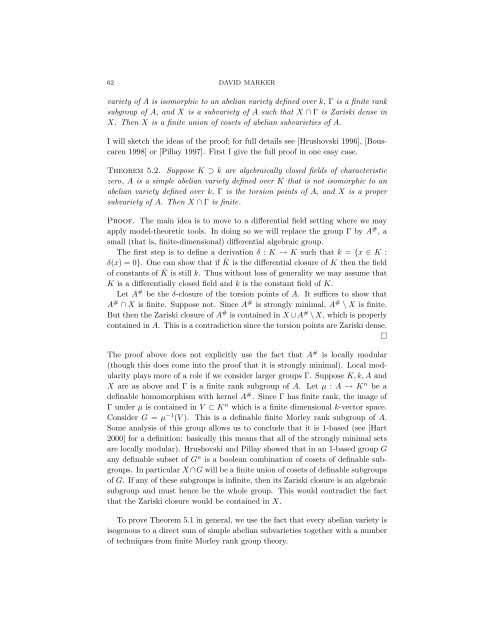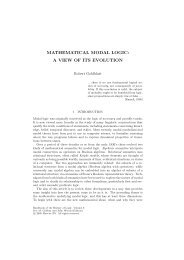Model Theory of Differential Fields
Model Theory of Differential Fields
Model Theory of Differential Fields
Create successful ePaper yourself
Turn your PDF publications into a flip-book with our unique Google optimized e-Paper software.
62 DAVID MARKERvariety <strong>of</strong> A is isomorphic to an abelian variety defined over k, Γ is a finite ranksubgroup <strong>of</strong> A, and X is a subvariety <strong>of</strong> A such that X ∩ Γ is Zariski dense inX. Then X is a finite union <strong>of</strong> cosets <strong>of</strong> abelian subvarieties <strong>of</strong> A.I will sketch the ideas <strong>of</strong> the pro<strong>of</strong>; for full details see [Hrushovski 1996], [Bouscaren1998] or [Pillay 1997]. First I give the full pro<strong>of</strong> in one easy case.Theorem 5.2. Suppose K ⊃ k are algebraically closed fields <strong>of</strong> characteristiczero, A is a simple abelian variety defined over K that is not isomorphic to anabelian variety defined over k, Γ is the torsion points <strong>of</strong> A, and X is a propersubvariety <strong>of</strong> A. Then X ∩ Γ is finite.Pro<strong>of</strong>. The main idea is to move to a differential field setting where we mayapply model-theoretic tools. In doing so we will replace the group Γ by A # , asmall (that is, finite-dimensional) differential algebraic group.The first step is to define a derivation δ : K → K such that k = {x ∈ K :δ(x) = 0}. One can show that if ˆK is the differential closure <strong>of</strong> K then the field<strong>of</strong> constants <strong>of</strong> ˆK is still k. Thus without loss <strong>of</strong> generality we may assume thatK is a differentially closed field and k is the constant field <strong>of</strong> K.Let A # be the δ-closure <strong>of</strong> the torsion points <strong>of</strong> A. It suffices to show thatA # ∩ X is finite. Suppose not. Since A # is strongly minimal, A # \ X is finite.But then the Zariski closure <strong>of</strong> A # is contained in X ∪ A # \ X, which is properlycontained in A. This is a contradiction since the torsion points are Zariski dense.□The pro<strong>of</strong> above does not explicitly use the fact that A # is locally modular(though this does come into the pro<strong>of</strong> that it is strongly minimal). Local modularityplays more <strong>of</strong> a role if we consider larger groups Γ. Suppose K, k, A andX are as above and Γ is a finite rank subgroup <strong>of</strong> A. Let µ : A → K n be adefinable homomorphism with kernel A # . Since Γ has finite rank, the image <strong>of</strong>Γ under µ is contained in V ⊂ K n which is a finite dimensional k-vector space.Consider G = µ −1 (V ). This is a definable finite Morley rank subgroup <strong>of</strong> A.Some analysis <strong>of</strong> this group allows us to conclude that it is 1-based (see [Hart2000] for a definition: basically this means that all <strong>of</strong> the strongly minimal setsare locally modular). Hrushovski and Pillay showed that in an 1-based group Gany definable subset <strong>of</strong> G n is a boolean combination <strong>of</strong> cosets <strong>of</strong> definable subgroups.In particular X ∩G will be a finite union <strong>of</strong> cosets <strong>of</strong> definable subgroups<strong>of</strong> G. If any <strong>of</strong> these subgroups is infinite, then its Zariski closure is an algebraicsubgroup and must hence be the whole group. This would contradict the factthat the Zariski closure would be contained in X.To prove Theorem 5.1 in general, we use the fact that every abelian variety isisogenous to a direct sum <strong>of</strong> simple abelian subvarieties together with a number<strong>of</strong> techniques from finite Morley rank group theory.
















